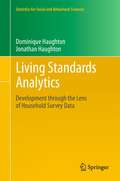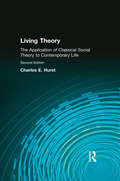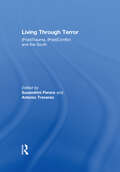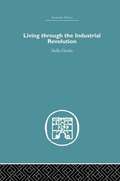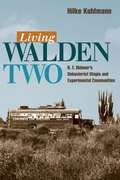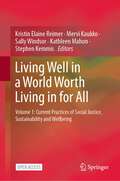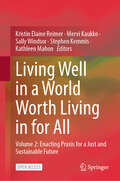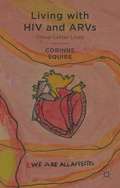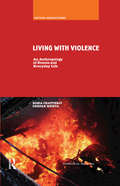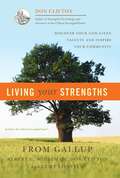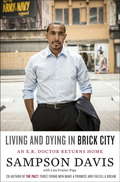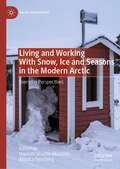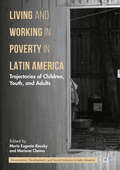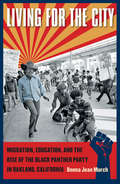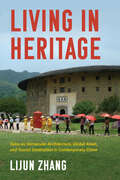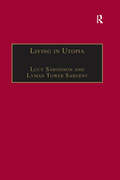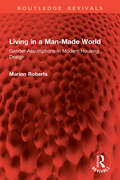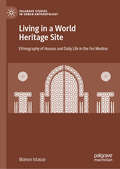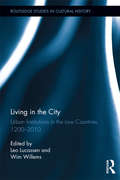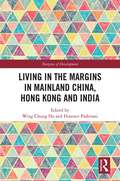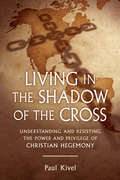- Table View
- List View
Living Sociologically: Concepts And Connections
by Eleanor Townsley Ronald JacobsStudents are drawn to topics of urgent sociological concern by a need to understand the forces that shape their world and their desire to make the world better. It can be challenging, however, for students to link sociological concepts with real-world applications. Living Sociologically: Concepts and Connections, Concise Edition helps students make those connections. This brief, engaging and accessible text offers an innovative, class-tested framework for teaching sociology. The "paired concepts" approach demonstrates the interdependent ways in which social forces work, encourages students to engage with complexity and contradiction, and provides them with critical, analytical thinking tools. The built-in student study guide is a unique adaptive learning program that will enable students to assess their learning and understanding as they move through the course, and provides feedback and an individualized learning path to help students master the material.
Living Standards Analytics
by Jonathan Haughton Dominique HaughtonThe purpose of this book is to introduce, discuss, illustrate, and evaluate the colorful palette of analytical techniques that can be applied to the analysis of household survey data, with an emphasis on the innovations of the past decade or so. Most of the chapters begin by introducing a methodological or policy problem, to motivate the subsequent discussion of relevant methods. They then summarize the relevant techniques, and draw on examples - many of them from the authors' own work - and aim to convey a sense of the potential, but also the strengths and weaknesses, of those techniques. This book is meant for graduate students in statistics, economics, policy analysis, and social sciences, especially, but certainly not exclusively, those interested in the challenges of economic development in the Third World. Additionally, the book will be useful to academics and practitioners who work closely with survey data. This is a book that can serve as a reference work, to be taken down from the shelf and perused from time to time.
Living Theory: The Application of Classical Social Theory to Contemporary Life
by Charles E. HurstLiving Theory: The Application of Classical Social Theory to Contemporary Life, 2nd edition analyzes major features of modern society from the classical theory point of view, and suggests how modern life might be explained from this viewpoint. The author examines the works of four classical figures - Marx, Durkheim, Simmel, and Weber - because of their continuing influence on social theory, and because they addressed many of the central issues we confront in modern society. Topics new to this edition include: New electronic technologies The battle over valued property The role of trust in society Governmental secrecy Trafficking in human organs
Living Through Terror
by Suvendrini Perera Antonio TraversoIn the era of war on terror, the term terror has tended to be applied to its sudden eruptions in the metropolises of the global north. This volume directs its attention to terror’s manifestations in other locations and lives. The title Living Through Terror refers both to the pervasiveness of terror in societies where extreme violence and war constitute the everyday processes of life as well as to the experience of surviving terror and living into the future. The contributions consider terror’s effects in those ignored and silenced locations where terror is either naturalised (the Philippines, South Africa, Timor Leste, Sri Lanka) or made invisible (the neo-liberal democracies of Australia and Italy).The stories of ruined places, displaced bodies and identities shattered and remade that emerge from these pages bring into view the socio-political systems, cultural geographies and regimes of territoriality through which terror is engendered and naturalised, and the institutions and imaginaries that continue to underpin them.The essays, literary writings and images collected here attend, in their different ways, to subjects living in and with terror as an element incorporated in their everyday, and to the processes by which terror exercises itself in their lives, whether it is perpetrated by state or non-state actors. Simultaneously, the contributions attest to the tactics subjects deploy to confront and negotiate conditions of terror, their attempts to live with and through terror and, ultimately, their strategies to recover through the everyday and the ordinary the seeds of life and hope.
Living Through the Industrial Revolution
by Stella DaviesFirst published in 1966, this revealing study looks closely into the lives of the men, women and children working in mines, workshops, factories and farms during the industrial revolution. It investigates the inventors whose new machines made the industrial revolution possible, and reflects on the new type of employer whose enterprise and energy in linking machine and labour power formed a new society. Where possible, contemporary accounts, letters, diaries and reports have been used so that the words of those living through this remarkable time can be heard - the words and thoughts of masters, workpeople, apprentice children, 'improving landlords' and farm labourers illuminate the prevailing attitudes of the period. An introductory chapter outlines previous methods of living and working and shows the first movements towards the industrial revolution. Describing successes and failures, lives of impoverishment and hardship, fortunes made and, sometimes, lost, and the effects of the new society, this enlightening study investigates how early struggles to cope with almost overwhelming problems are now seen as the beginnings of the comparatively comfortable conditions we benefit from today.
Living Walden Two: B. F. Skinner's Behaviorist Utopia and Experimental Communities
by Hilke KuhlmanIn Walden Two, behavioral psychologist B. F. Skinner describes one of the most controversial fictional utopias of the twentieth century. During the 1960s and 70s, this novel went on to inspire approximately three dozen actual communities, which are entertainingly examined in Hilke Kuhlmann's Living Walden Two. In the novel, behavioral engineers use positive reinforcement in organizing and "gently guiding" all aspects of society, leaving the rest of the citizens "free" to lead happy and carefree lives. Among the real-world communities, a recurrent problem in moving past the planning stages was the nearly ubiquitous desire among members to be gentle guides, coupled with strong resistance to being guided. In an insightful and often hilarious narrative, Hilke Kuhlmann explores the dynamics of the communities, with an in-depth examination of the two surviving Skinnerian communities: Comunidad Los Horcones in Mexico, and Twin Oaks in Virginia. Drawing on extensive interviews with the founders and key players in the Walden Two communities, Kuhlmann redefines the criteria for their success by focusing on the tension between utopian blueprints for a new society and communal experiments' actual effects on individual lives.
Living Well in a World Worth Living in for All: Volume 1: Current Practices of Social Justice, Sustainability and Wellbeing
by Stephen Kemmis Kathleen Mahon Mervi Kaukko Kristin Elaine Reimer Sally WindsorThis open access book is the first of a two-volume series focusing on how people are being enabled or constrained to live well in today’s world, and how to bring into reality a world worth living in for all. The chapters offer unique narratives drawing on the perspectives of diverse groups such as: asylum-seeking and refugee youth in Australia, Finland, Norway and Scotland; young climate activists in Finland; Australian Aboriginal students, parents and community members; families of children who tube feed in Australia; and international research students in Sweden. The chapters reveal not just that different groups have different ideas about a world worth living in, but also show that, through their collaborative research initiative, the authors and their research participants were bringing worlds like these into being. The volume extends an invitation to readers and researchers in education and the social sciences to consider ways to foster education that realises transformed selves and transformed worlds: the good for each person, the good for humankind, and the good for the community of life on the planet. The book also includes theoretical chapters providing the background and rationale behind the notion of education as initiating people into ‘living well in a world worth living in'. An introductory chapter discusses the origins of the concept and the phrase.
Living Well in a World Worth Living in for All: Volume 2: Enacting Praxis for a Just and Sustainable Future
by Stephen Kemmis Kathleen Mahon Mervi Kaukko Kristin Elaine Reimer Sally WindsorThis open access book is the second of a two-volume series that explores how people are living well and creating a “World Worth Living in for All”. It engages in deep listening of voices from across the world and considers the role of education in creating a more just and sustainable world for the future. The book asks what can be learnt to create change in policy and practice in order to enact praxis. It showcases chapters from international authors who discuss current or new projects to address the overarching questions explored in the book. It also provides an overview of perspectives that connect both volumes and the individual projects presented together through the lens of practice architectures.
Living With Hiv And Arvs
by Corinne SquireThis book explores the possibilities and difficulties of living with HIV and ARVs, or antiretroviral treatment, today. It draws on HIV-positive people's stories from both the UK and the South African epidemics and offers a deep understanding of the continuing difficulties of living with HIV and the effective strategies for coping that have evolved.
Living With Violence: An Anthropology of Events and Everyday Life (Critical Asian Studies)
by Roma Chatterji Deepak MehtaThis book gives a detailed account of the ‘communal riots’ between Hindus and Muslims in Mumbai in 1992-93. It departs from the historiography of the riot, which assumes that Hindu-Muslim conflict is independent of the participants of the violence.Speaking to and interacting with the residents of Dharavi, the largest shanty town in the city, the authors collected a wide range of narrative accounts of the violence and the procedures of rehabilitation that accompanied the violence. The authors juxtapose these narrative accounts with public documents exploring the role language, work, housing and rehabilitation have on the day-to-day life of people who live with violence.
Living Your Strengths: Discover Your God-Given Talents and Inspire Your Community
by Donald O. Clifton Albert L. Winseman Curt LiesveldAmerican churches are experiencing a power shortage. It's not the kind of power shortage that can be fixed by opening natural gas fields or drilling oil wells or building electrical plants. The shortage is in fulfilled human potential. In churches all across the United States, people aren't harnessing the power of their innate gifts. They are not fulfilling God's purpose in their lives. And most people don't even know it.
Living and Dying in Brick City: Stories from the Front Lines of an Inner-City E.R.
by Sampson Davis Lisa Frazier PageA riveting personal exploration of the healthcare crisis facing inner-city communities, written by an emergency room physician who grew up in the very neighborhood he is now serving Sampson Davis is best known as one of three friends from inner-city Newark who made a pact in high school to become doctors. Their book The Pact and their work through the Three Doctors Foundation have inspired countless young men and women to strive for goals they otherwise would not have dreamed they could attain. In this book, Dr. Davis looks at the healthcare crisis in the inner city from a rare perspective: as a doctor who works on the front line of emergency medical care in the community where he grew up, and as a member of that community who has faced the same challenges as the people he treats every day. He also offers invaluable practical advice for those living in such communities, where conditions like asthma, heart disease, stroke, obesity, and AIDS are disproportionately endemic. Dr. Davis's sister, a drug addict, died of AIDS; his brother is now paralyzed and confined to a wheelchair as a result of a bar fight; and he himself did time in juvenile detention--a wake-up call that changed his life. He recounts recognizing a young man who is brought to the E.R. with critical gunshot wounds as someone who was arrested with him when he was a teenager during a robbery gone bad; describes a patient whose case of sickle-cell anemia rouses an ethical dilemma; and explains the difficulty he has convincing his landlord and friend, an older woman, to go to the hospital for much-needed treatment. With empathy and hard-earned wisdom, Living and Dying in Brick City presents an urgent picture of medical care in our cities. It is an important resource guide for anyone at risk, anyone close to those at risk, and anyone who cares about the fate of our cities. Praise for Living and Dying in Brick City "This book just might save your life. Sampson Davis shares fascinating stories from the E.R. and addresses the inner-city health crisis. His book is an important investment in your most valuable resource: your health."--Suze Orman, author of The Money Class "This book is living proof that behind the boarded-up windows of one of America's most neglected cities, beyond the sorrow and the pain, there is much more than we've come to expect. There is hope. There is change. There is redemption for Brick City. The book will open your eyes to a part of the world that most of us only see from behind the wheel of a tightly locked car. Sampson Davis is not afraid to lift heavy objects in this world. I'm glad he shared his journey with us, so that we know it is possible."--James McBride, author of The Color of WaterFrom the Hardcover edition.
Living and Dying in a Virtual World: Digital Kinships, Nostalgia, and Mourning in Second Life (Palgrave Macmillan Memory Studies)
by Margaret Gibson Clarissa CardenThis book takes readers into stories of love, loss, grief and mourning and reveals the emotional attachments and digital kinships of the virtual 3D social world of Second Life. At fourteen years old, Second Life can no longer be perceived as the young, cutting-edge environment it once was, and yet it endures as a place of belonging, fun, role-play and social experimentation. In this volume, the authors argue that far from facing an impending death, Second Life has undergone a transition to maturity and holds a new type of significance. As people increasingly explore and co-create a sense of self and ways of belonging through avatars and computer screens, the question of where and how people live and die becomes increasingly more important to understand. This book shows how a virtual world can change lives and create forms of memory, nostalgia and mourning for both real and avatar based lives.
Living and Working With Snow, Ice and Seasons in the Modern Arctic: Everyday Perspectives (Arctic Encounters)
by Monica Tennberg Hannah Strauss-MazzulloThis book describes everyday practices of life in changing Arctic winter conditions. The authors explore the contemporary and situated outdoor practices in different work settings in Finnish Lapland and investigate how, for example, tourism, reindeer herding, cattle breeding and urban snow management adapt to the physically limiting or enabling features of cold temperatures, snow and ice. The book also highlights individual and societal adjustments to such harsh conditions and their seasonal changes in mobility, including winter cycling, use of snow mobiles and walking with studded shoes. The impact of a warming climate is a great concern for those utilising the enabling qualities of winter weather. The need, then, for continuous adaptation in everyday practices of work and mobility will increase in the future.
Living and Working in Poverty in Latin America: Trajectories of Children, Youth, and Adults (Governance, Development, and Social Inclusion in Latin America)
by María Eugenia Rausky Mariana ChavesThis edited volume studies the complex interrelation of poverty, work, and different stages in the life course, and how it contributes to the permanent existence of poverty and inequality in vulnerable groups in society. Mechanisms of productions and reproduction of these relationships are identified through empirical research carried out in four Latin American countries: Mexico, Argentina, Brazil, and Cuba. This book centers on the experiences of individuals in those less favored social groups who may have suffered structural poverty for decades, or who may have been simply deprived of a basic income to cover their most essential needs.
Living for the City: Migration, Education, and the Rise of the Black Panther Party in Oakland, California
by Donna Jean MurchIn this nuanced and groundbreaking history, Donna Murch argues that the Black Panther Party (BPP) started with a study group. Drawing on oral history and untapped archival sources, she explains how a relatively small city with a recent history of African American settlement produced such compelling and influential forms of Black Power politics. During an era of expansion and political struggle in California's system of public higher education, black southern migrants formed the BPP. In the early 1960s, attending Merritt College and other public universities radicalized Huey Newton, Bobby Seale, and many of the young people who joined the Panthers' rank and file. In the face of social crisis and police violence, the most disfranchised sectors of the East Bay's African American community--young, poor, and migrant--challenged the legitimacy of state authorities and of an older generation of black leadership. By excavating this hidden history,Living for the Citybroadens the scholarship of the Black Power movement by documenting the contributions of black students and youth who created new forms of organization, grassroots mobilization, and political literacy.
Living in Heritage: Tulou as Vernacular Architecture, Global Asset, and Tourist Destination in Contemporary China (Material Vernaculars)
by Lijun ZhangYongding County in southeast China is famous for its large, multistory communal vernacular buildings known as tulou, translated "rammed earth building." These structures were designated a UNESCO World Heritage Site in 2008. Living in Heritage introduces readers outside of China to this classic example of local Chinese architecture in the context of contemporary heritage preservation and tourism.Focusing on the Yongding Hakka Tulou Folk Culture Village, which is part of Hongkeng Village, author Lijun Zhang examines the on-the-ground processes and effects of heritage-making, UNESCO-inspired tourism, and how locals negotiate the dramatic transformation of their daily, social, and economic lives. Within an age of cultural change beginning at the start of the 21st century, Living in Heritage explores how the tulou phenomenon as heritage has and continues to be transformed into cultural, economic, or political capital. Through her careful study, Zhang reveals how the blurring of formerly distinct domains—private and public, local and global—gives rise to a living museum that now relies on insiders and outsiders to preserve their way of life.Living in Heritage offers an in-depth ethnographic account of the people dwelling and working within traditional tulou architecture in the 21st century.
Living in Utopia: New Zealand’s Intentional Communities
by Lyman Tower Sargent Lucy SargissonUtopia is, literally, the good place that is no place. Utopias reveal people's dreams and desires and they may gesture towards different and better ways of being. But they are rarely considered as physical, observable phenomena. In this book Sargisson and Sargent, both established writers on utopian theory, turn their attention to real-life utopian communities. The book is based on their fieldwork and extensive archival research in New Zealand, a country with a special place in the history of utopianism. A land of opportunity for settlers with dreams of a better life, New Zealand has, per capita, more intentional communities - groups of people who have chosen to live and sometimes work together for a common purpose - than any country in the world. Sargisson and Sargent draw on the experiences of more than fifty such communities, to offer the first academic survey of this form of living utopian experiment. In telling the story of the New Zealand experience, Living in Utopia provides both transferable lessons in community, cooperation and social change and a unique insight into the utopianism at the heart of politics, society, and everyday life.
Living in Worlds of Music
by Minette MansInformed by her in-depth ethnomusical knowledge, the result of detailed fieldwork, Mans's book is about musical worlds and how we as people inhabit them. The book asserts that an understanding of our musical worlds can be a transformative educational tool that could have a significant role to play in multicultural music and arts education. She explores the way in which musical expression, with its myriad cultural variations, reveals much about identity and cultural norms, and shows how particular musical sounds are aesthetically related to these norms. The author goes further to suggest that similar systems can be detected across cultures, while each world remains colored by a distinctive soundscape. Mans also looks at the way each cultural soundscape is a symbolic manifestation of a society's collective cognition, sorting musical behavior and sounds into clusters and patterns that fulfill each society's requirements. She probes the fact that in today's globalized and mobile world, as people move from one society to another, cross-cultural acts and hybrids result in a number of new aesthetics. Finally, in addition to three personal narratives by musicians from different continents, the author has invited scholars from diverse specializations and locations to comment on different sections of the book, opening up a critical dialogue with voices from different parts of the globe. Musical categorization, identity, values, aesthetic evaluation, creativity, curriculum, assessment and teacher education are some of the issues tackled in this manner.
Living in a Dangerous Climate
by Renée HetheringtonLiving in a Dangerous Climate provides a journey through human and Earth history, showing how a changing climate has affected human evolution and society. Is it possible for humanity to evolve quickly, or is slow, gradual, genetic evolution the only way we change? Why did all other Homo species go extinct while Homo sapiens became dominant? How did agriculture, domestication, and the use of fossil fuels affect humanity's growing dominance? Do today's dominant societies - devoted as they are to Darwinism and "survival of the fittest" - contribute to our current failure to meet the hazards of a dangerous climate? Unique and thought provoking, the book links scientific knowledge and perspectives of evolution, climate change, and economics in a way that is accessible and exciting for the general reader. The book is also valuable for courses on climate change, human evolution, and environmental science.
Living in a Man-Made World: Gender Assumptions in Modern Housing Design (Routledge Revivals)
by Marion RobertsThere are powerful assumptions about gender divisions inscribed in the built environment. Housing is the site of some complex processes in society. In making and remaking their homes, women and men define their place in the world and are defined by it. Taking a historical perspective, Living in a Man-Made World (originally published in 1991) is the first to make a complete examination of the relationship of gender to housing design. Design is seen in broad terms and revealed as part of the social process of society, rather than a separate sphere in which the architect has sole responsibility for decision making. Many of the ills of the contemporary environment can be traced to the barriers that have been built up between the concerns of social policy, planning and architecture. By breaking down these barriers through a synoptic study of how gender assumptions have operated in the design of housing, this book points the way to how improvements in design and in the built environment may be better achieved.
Living in a World Heritage Site: Ethnography of Houses and Daily Life in the Fez Medina (Palgrave Studies in Urban Anthropology)
by Manon IstasseThrough a thick ethnography of the Fez medina in Morocco, a World Heritage site since 1981, Manon Istasse interrogates how human beings come to define houses as heritage. Istasse interrogates how heritage appears (or not) when inhabitants undertake construction and restoration projects in their homes, furnish and decorate their spaces, talk about their affective and sensual relations with houses, face conflicts in and about their houses, and more. Shedding light on the continuum between houses-as-dwellings and houses-as-heritage, the author establishes heritage as a trajectory: heritage as a quality results from a ‘surplus of attention’ and relates to nostalgia or to a feeling of threat, loss, and disappearance; to values related to purity, materiality, and time; and to actions of preservation and transmission. Living in a World Heritage site provides a grammar of heritage that will allow scholars to question key notions of temporality and nostalgia, the idea of culture, the importance of experts, and moral principles in relation to heritage sites around the globe.
Living in the City: Urban Institutions in the Low Countries, 1200–2010 (Routledge Studies in Cultural History)
by Leo Lucassen Wim WillemsThe city is a place to find shelter, a market place, and an elevator for social mobility and success. But the city is also a place that frightens people and that can marginalize newcomers. Living in the City tries to understand what pulls people to the city since the High Middle Ages, focusing on one of the earliest urbanized regions in the world, the Low Countries. The book is a quest for new insights that leads the reader from Medieval Ghent and Bruges, through the Dutch Golden Age and the mass urbanization in the age of Industrialization to the present Eurodelta. A region that emerged in the last century with Antwerp, Rotterdam and Amsterdam as nodal points in a global urban network. To understand the motivations of so many to settle in cities this book focuses on a wide variety of urban institutions. What was the role of churches, guilds and businesses, but also theaters, architecture, parks and pavements? What were the cultural, economic, social, political and spatial dynamics that transformed cities into centers of creativity and innovation? How did the attractiveness of cities change over time, when cities lost their autonomy and became part of the nation state and global forces? In this book a team of internationally reknown scholars (in the field of history, art, literature, economy and the social sciences) look for continuity and change in the last eight centuries of urban developments in one of the most remarkable urban regions of the world.
Living in the Margins in Mainland China, Hong Kong and India (Margins of Development)
by Wing Chung Ho Florence PadovaniWith a range of case studies from Asia, this book sheds light on empirical realizations of marginality in a globalized context using first-hand original research.In the late 2000s, the financial crisis witnessed the fragility of high levels of market integration and the vulnerability of globalisation. Since then, the world seems to have entered an epoch of anxiety featuring populism with varying degrees of protectionism and nationalism. What is the nature of this populist mood as a backlash against globalisation? How do people feel about it and act upon it? Why should specific intellectual attention be paid to the increasingly marginalised by the recent macroscopic structural changes? These are the questions addressed by the contributors of this book, illustrated with specific cases from mainland China, Hong Kong and India, all of which have undergone substantial populist or nationalist movements since 2010.A valuable resource for sociologists looking to understand the impacts of globalization, especially those with a particular interest in Asia.
Living in the Shadow of the Cross: Understanding and Resisting the Power and Privilege of Christian Hegemony
by Paul KivelHow our dominant Christian worldview shapes everything from personal behavior to public policy (and what to do about it)Over the centuries, Christianity has accomplished much which is deserving of praise. Its institutions have fed the hungry, sheltered the homeless, and advocated for the poor. Christian faith has sustained people through crisis and inspired many to work for social justice.Yet although the word "Christian" connotes the epitome of goodness, the actual story is much more complex. Over the last two millennia, ruling elites have used Christian institutions and values to control those less privileged throughout the world. The doctrine of Christianity has been interpreted to justify the killing of millions, and its leaders have used their faith to sanction participation in colonialism, slavery, and genocide. In the Western world, Christian influence has inspired legislators to continue to limit women's reproductive rights and has kept lesbians and gays on the margins of society.As our triple crises of war, financial meltdown, and environmental destruction intensify, it is imperative that we dig beneath the surface of Christianity's benign reputation to examine its contribution to our social problems. Living in the Shadow of the Cross reveals the ongoing, everyday impact of Christian power and privilege on our beliefs, behaviors, and public policy, and emphasizes the potential for people to come together to resist domination and build and sustain communities of justice and peace.Paul Kivel is the award-winning author of Uprooting Racism and the director of the Christian Hegemony Project. He is a social justice activist and educator who has focused on the issues of violence prevention, oppression, and social justice for over forty-five years.

